What Are The Three Types Of Skeletons Found In Animals
An introduction to the different types of animals that brand upwards the animal kingdom Animalia.
Download the Gratis accompanying question sheet to test your animal knowledge!
Page Index
Use the links beneath to find the information you need (or continue reading for a complete overview of the fauna kingdom).
- Download the FREE question sheet
- Different Types of Animals: Introduction
- Animalia: The Animal Kingdom
- The Ii 'Main' Types of Animals: Invertebrates and Vertebrates
- Basic Brute Classification
- Types of Invertebrate
- Sponges
- Flatworms
- Major types of flatworm
- Roundworms / Nematodes
- Cnidarians
- Major types of cnidarian
- Mollusks
- Notable Types Of Mollusk
- Arthropods
- Insects
- Notable Types Of Insect
- Crustaceans
- Notable Types Of Crustacean
- Arachnids
- Notable Types Of Arachnid
- Types of Vertebrate
- Fish
- Notable Fish Groups
- Amphibians
- Major Types Of Amphibian
- Reptiles
- Major Types Of Reptile
- Birds
- Notable Types Of Bird
- Mammals
- Major Mammal Groups
- Related Pages On Active Wild
Free Animals Question Sheet For Use With This Page

Click here or on the prototype to a higher place to view / download a free printable question sheet for employ with this page. (PDF file, 1.2 Mb). If the question sail opens in your browser rather than downloading, right-click on the question sheet and select 'download'.
Unlike Types Of Animals: Introduction
On this page is a list of the main types of animals. Rather than looking at individual species such equally 'tiger' or 'monarch butterfly', this is a list of the major groups of animals.
- If y'all want information on hundreds of private species, including 'tiger' and 'monarch butterfly', then check out this page: A To Z Animals With Pictures & Facts
Outset we take a look at the two main types of animate being: invertebrates and vertebrates. We so look at smaller groups within these larger groups.
For each blazon of fauna, yous'll observe links to more data about fifty-fifty smaller groups and notable species within each group.
This folio is an overview of the master types of animals; there are many other brute groups, both living and extinct!
We hope yous enjoy this exploration of the animal kingdom. If y'all take any questions then feel free to ask in the comments section at the pes of the page.
Animalia: The Fauna Kingdom

An organism is a living thing. If we think of every single organism on Earth being part of one large group, then that group can exist split into smaller groups of organisms that are more than like each other than they are to other organisms.
Animalia – the animal kingdom – is one of several large groups of living things.
Animals have a detail set of characteristics that separates them from other organisms such as plants, fungi and bacteria.
Other kingdoms include Plantae – the plant kingdom, and Fungi, the kingdom that contains organisms such equally mushrooms and molds.
Characteristics of animals include: being multicellular (i.e. they consist of more than one cell); beingness able to move (for at to the lowest degree function of their lives); breathing oxygen; reproducing sexually; and beingness unable to produce their own food (i.due east. they can't get energy from sunlight).
The animal kingdom is divided into many smaller groups. On this folio we will take a expect at some of the different types of animals and their characteristics. We'll concentrate on the main animal groups, only volition also have a look at a number of notable smaller animal types.
Unlike Types Of Animals
The Ii 'Master' Types of Animals: Invertebrates and Vertebrates
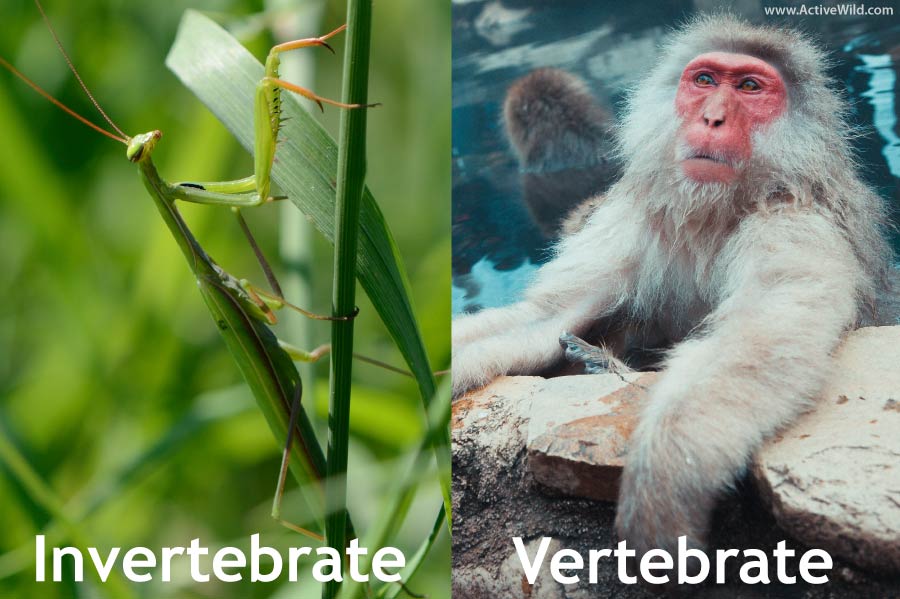
There are two primary types of brute: invertebrates and vertebrates. Invertebrates are animals that don't have a backbone; vertebrates are animals that do.
Of the i.4 one thousand thousand or then known animal species, around 95% (or more than) are invertebrates. Of these, almost 1 million are insects.
Only around v% of known animals are chordates (chordates are animals that either have a courage, or a similar structure known as a notochord).
Dissimilar vertebrates, invertebrates don't actually class a single group of related animals. In fact, some invertebrates are more closely related to vertebrates than they are to other invertebrates.
Although the word 'invertebrates' isn't an 'official' animate being group, it does form a useful distinction betwixt two very different types of animals. Considering of this, we've separated the animal groups on this page into invertebrates and vertebrates.
Animal Nomenclature Basics
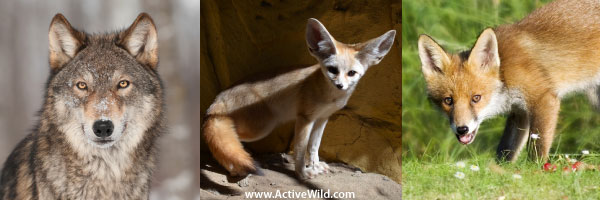
A 'kingdom' such as the animal kingdom or the plant kingdom consists of groups of organisms that share certain characteristics.
A kingdom can itself be divided into smaller groups of organisms that are more closely-related to each other than they are to other organisms.
Each of these smaller groups can then be further divided into even smaller groups of organisms that are even more than closely-related. This continues until nosotros get right down to individual species.
(In fact, even an individual species can go divided into smaller groups, chosen subspecies. The domestic dog, for example, is a subspecies of grey wolf.)
The science of placing species into groups is known as taxonomy. Each taxonomic stage, or 'rank' has its ain proper name. From kingdom to species, the basic taxonomic ranks are: kingdom, phylum, course, gild, family and species.
- You can discover out more nigh animal classification on this folio: Creature Classification
Types of Animals: Invertebrates
Beneath is a selection of the major types of invertebrates.
Sponges

- Phylum: Porifera
Looking like bulbous, hollow plants, sponges are amid the near basic of all animals. They lack a nervous organization and a stomach, and most species are capable of move simply in their juvenile form.
At that place are between 6,000 and ix,000 known species of sponge (as with many areas of taxonomy, at that place is a great deal of discrepancy between information on the verbal number of sponges). Nearly all sponges are institute in marine habitats, although there are a modest number of freshwater sponges.
Sponges are filter feeders. Inside a sponge's trunk are cells with whip-like projections called flagella. The movement of the flagella causes water to move through the sponge. The sponge feeds on microorganisms independent within the water.
One of the start scientists to realize that sponges were animals rather than plants was Aristotle.
Dorsum to page alphabetize
Flatworms

- Phylum: Platyhelminthes
The species in the phylum Platyhelminthes are also known every bit flatworms. These invertebrate animals range in size from microscopic species to tapeworms that can be up to 25m (82 ft.) in length.
Flatworms lack a body cavity, and have neither a circulatory nor a respiratory system. They are the simplest animals to exhibit 'bilateral symmetry' (i.e. to accept bodies that are symmetrical). Flatworms have existed for hundreds of millions of years and were the first carnivorous hunters.
Many living flatworms are parasitic. They brand their way into a host organism and feed on its body from the inside. This can be harmful and fifty-fifty deadly to the host animal.
Often the eggs of parasitic flatworms are eaten past a small animal, in whose trunk the flatworm undergoes the showtime stage of its development. When the smaller host animal is eaten by a larger animal, the flatworm sets up a permanent home in its new host. It feeds off the host animal and besides lays its eggs in the host's body. These are passed by the host brute and the bicycle begins over again.
Some flatworms make their way through more than than one host before embedding themselves in their final host.
Major types of flatworm:
- Form Turbellaria – free-moving, not-parasitic flatworms
- Class Cestoda – tapeworms and related species, all parasitic
- Clade Trematoda – flukes, all parasitic
- Class Monogenea – parasites that alive infest the exterior of a host species' trunk
Dorsum to page index
Roundworms / Nematodes
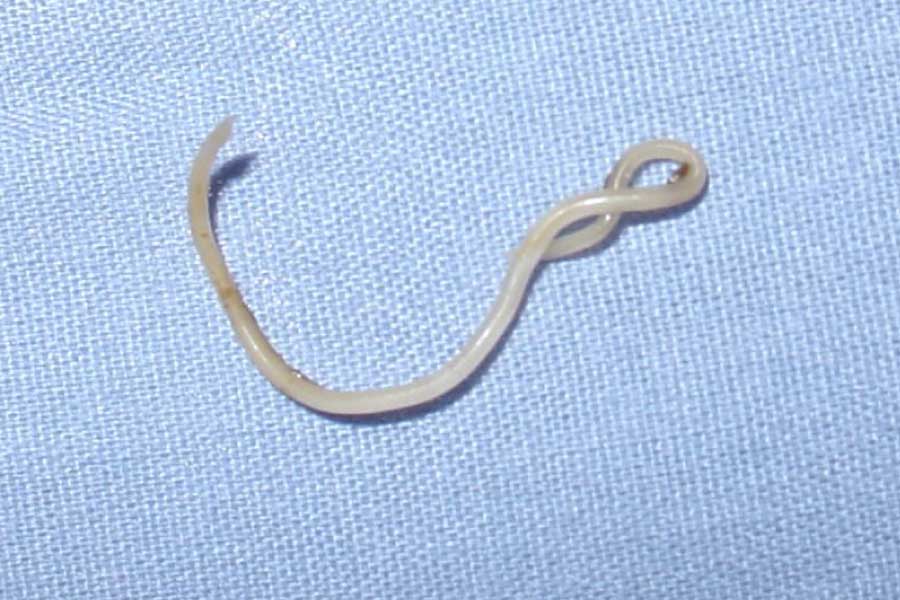
- Phylum: Nematoda
Roundworms accept long, cylindrical bodies. While well-nigh are microscopic, some can achieve lengths of 13m (42.6ft.). Effectually 3,500 roundworm species are currently recognized, but some biologists believe that the actual number of species is closer to 40,000 or more.
One of the largest roundworms is Placentonema gigantissima. It is a parasite that lives in the placenta of a sperm whale.
Different flatworms, who apply the same opening both to accept in nutrient and to expel waste material, roundworms have a more adult digestive organization which has separate openings for each task.
In that location are very few ecosystems on Earth in which roundworms are not present. These adaptable animals are found in polar, mountainous, tundra and desert regions and well every bit cloak-and-dagger and on the sea bed.
There are more than private roundworms than any other blazon of animate being. Information technology is estimated that there are 5 billion roundworms in every acre of fertile garden soil; 60 billion roundworms for each living person; and that roundworms account for 80% of all living animals.
Dorsum to page index
Cnidarians
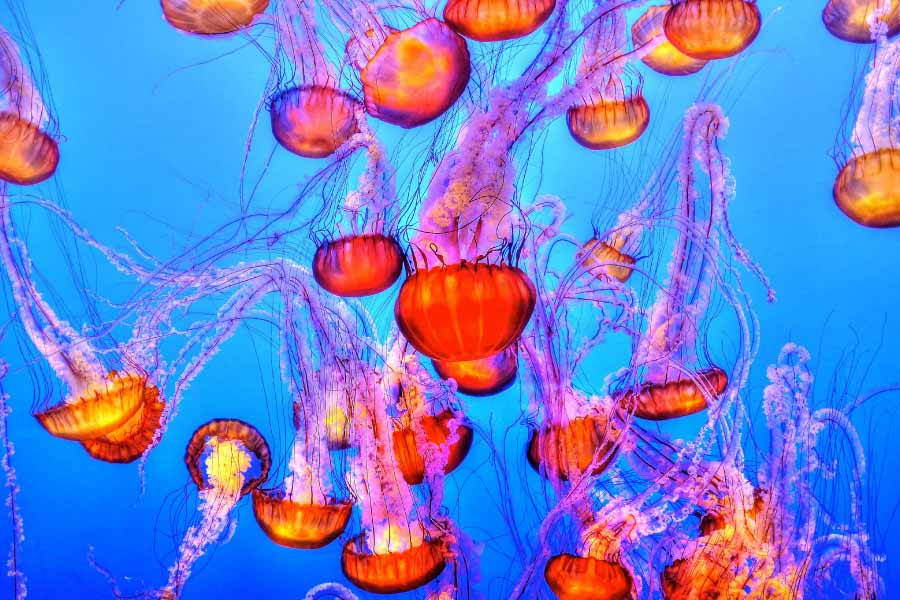
- Phylum: Cnidaria
The phylum Cnidaria includes animals such equally corals, sea anemones and jellyfish. They have soft bodies with radial symmetry (i.east. they are symmetrical around a primal point, with no 'back' or 'forepart' side).
Cnidarians such as corals and sea anemones permanently adhere themselves to underwater surfaces after a short free-swimming larval stage. Others, such every bit jellyfish and the Portuguese man o' state of war, are costless-swimming even in machismo.
All cnidarians are carnivores. They are equipped with cells called cnidocytes, which deploy venom via a infinitesimal spear-like construction. Cnidocytes are adapted for capturing prey, and for defense against predators. Information technology is these cells that are responsible for a jellyfish's painful sting.
Major Types of Cnidarian
- Form Anthozoa (sea anemones and corals)
- Grade Scyphozoa (jellyfish)
- Class Cubozoa (box jellyfish)
- Class Hydrozoa (a group of related animals that includes colonial species such as the Portuguese man o' war)
Back to page index
Mollusks
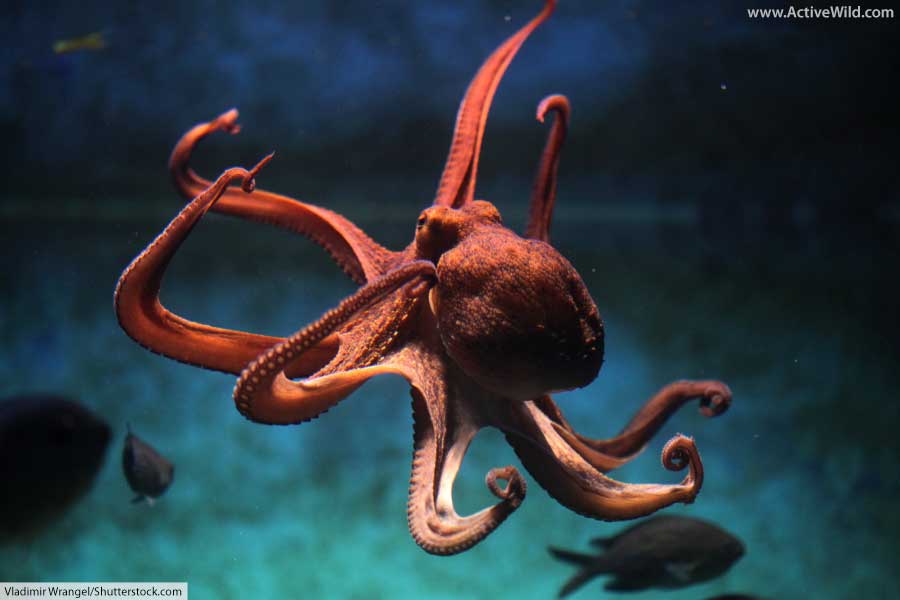
- Phylum: Mollusca
The phylum Mollusca, whose members are known as mollusks (spelt molluscs in British English), contains both the largest and the most intelligent invertebrates. This grouping contains animals as diverse as oysters and octopuses.
The Catalogue of Life (link) currently lists 65,442 species of clam, although other estimates suggest that around 85 grand species are recognized.
Bivalves such as oysters and clams, gastropods such as snails and slugs, and cephalopods such as octopuses, squid and cuttlefish are all mollusks.
All mollusks have a mantle, which is a thick muscular wall that contains respiratory and other organs. In cephalopods, the curtain also functions equally a jet, which pushes the brute through the water.
The colossal squid is the largest living mollusk. Information technology reaches an estimated length of around 14 m (46 ft.) and is institute in the Antarctic ocean.
Octopuses are the virtually intelligent invertebrates. They accept been observed using tools, solving problems and even playing – a behavior associated with intelligence.
Notable Types Of Mollusk
- Class Bivalvia – bivalves (oysters, clams, cockles, mussels and related species)
- Form Gastropoda – gastropods (slugs and snails)
- Form Cephalopoda – cephalopods (squid, cuttlefish, octopuses)
Back to page alphabetize
Arthropods
- Phylum: Arthropoda
Arthropods are a huge and diverse group of animals. There are over a 1000000 known species in the phylum Arthropoda, which contains all insects, crustaceans, arachnids, horseshoe crabs and myriapods (centipedes & millipedes) too equally several other invertebrate groups.
The proper name 'arthropod' ways 'jointed foot'. All arthropods have segmented bodies, paired jointed appendages (i.e. legs, antennae, etc.) and hard exoskeletons.
Below we look in more detail at some notable arthropod groups.
Back to page index
Insects
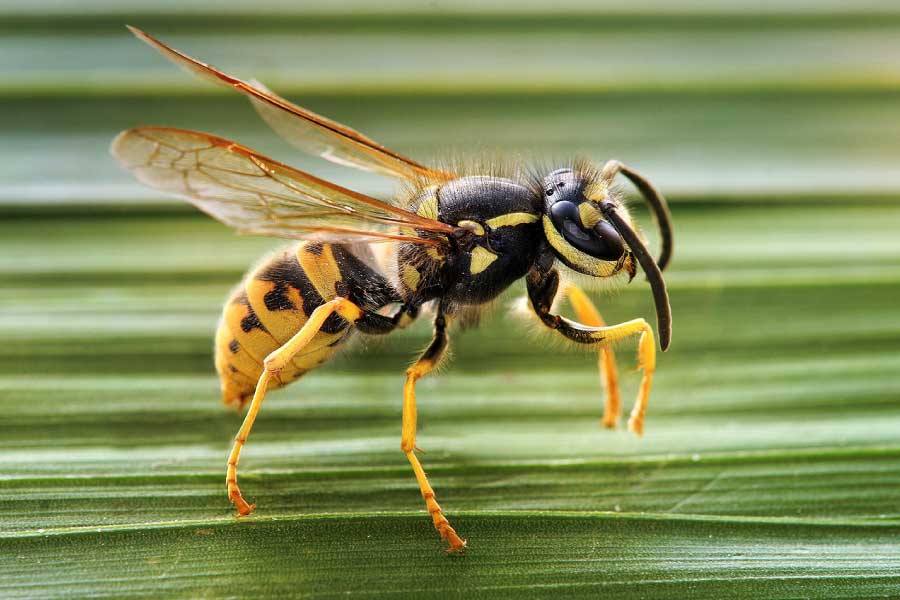
- Class: Insecta
Insects are thought to take appeared during the Silurian Period, between 443.eight–419.2 million years agone. (That's over 200 million years earlier dinosaurs!)
The commencement known insect is Rhyniognatha hirsti, which resembled a mod-twenty-four hour period silverfish and walked the World 396 million years ago.
Today insects are past far the largest single group of animals in terms of number of species. Over ane million insect species have been described (i.e. named and scientifically accustomed as existence an private species).
There are more than 3 times known insect species than there are known institute species. Insects make up more than one-half of all known organisms.
In short, there are a lot of different types of insects!
Characteristics of all insects include: a hard exoskeleton, a trunk comprising three parts: head, thorax and abdomen, three pairs of jointed legs, a single pair of antennae and a pair of compound optics.
The largest grouping (in terms of number of species) within Insecta is Coleoptera – the beetles. There are over 320,000 recognized species of protrude.
The world'due south largest insect is the larval phase of the Goliath beetle Goliathus goliatus. The giant weta Deinacrida heteracantha – a giant, flightless cricket institute in New Zealand – vies with the elephant beetles and Goliath beetles for the title of heaviest adult insect.
The earth'south smallest insect is the parasitic wasp Dicopomorpha echmepterygis, which is constitute in the United States.
Notable Types Of Insect
- Order Coleoptera – beetles
- Order Diptera – flies
- Social club Hymenoptera – wasps, bees and ants
- Lodge Mantodea – mantises
- Order Lepidoptera – butterflies and moths
- Order Blattodea – cockroaches and termites
- Social club Odonata – dragonflies
Discover More than
- Y'all can find out more than about insects on this page: Insects: The Ultimate Guide
Dorsum to page alphabetize
Crustaceans
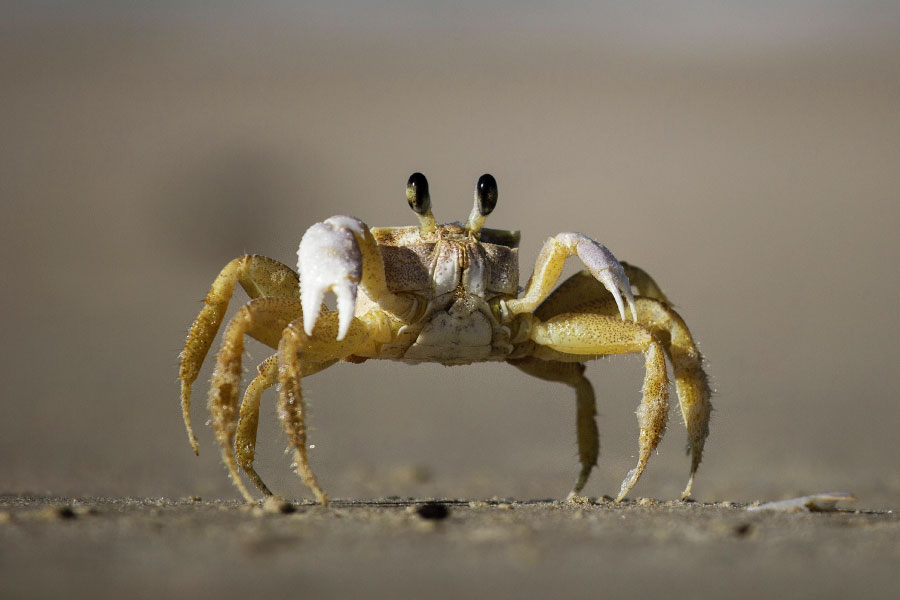
- Subphylum: Crustacea
With around 67,000 species, Crustacea is 1 of the largest arthropod groups. Crustaceans are extremely varied; the grouping includes crabs, lobsters, shrimps, krill, woodlice and barnacles. Virtually crustaceans live in water, but some – including woodlice – are institute on land.
Typical crustacean characteristics include a segmented body with a hard exoskeleton, two pairs of antennae and a pair of chemical compound eyes, which are oftentimes mounted on stalks.
A feature of crustaceans not seen in other arthropods is the presence of 'biramous limbs'. These are limbs that branch into two. A crustacean's 2nd pair of antennae may also exist biramous.
The world's smallest crustacean is the tiny marine parasite Tantulacus dieteri, which has a body length of 85 micrometers (0.0033 in). This miniature crustacean, which infests other small marine crustaceans, may be the earth's smallest arthropod. (Some mites of class Arachnida are equally as tiny.)
The largest crustacean is the Japanese spider crab, which has a maximum claw to claw length of 5.v meters (18 ft.).
The heaviest crustacean is the American lobster, Homarus americanus. With a mass of over 20 kg (44 lb.), it is besides the earth'southward heaviest arthropod.
Notable Types Of Crustacean
- Order Euphausiacea – krill
- Infraorder Brachyura – venereal
- Suborder Oniscidea – woodlice
- Infraorder Astacidea – lobsters, crayfish and related animals
- Infraclass Cirripedia – barnacles
Discover More
- You can find out more than most crustaceans on this folio: Crustaceans: The Ultimate Guide
Back to page alphabetize
Arachnids
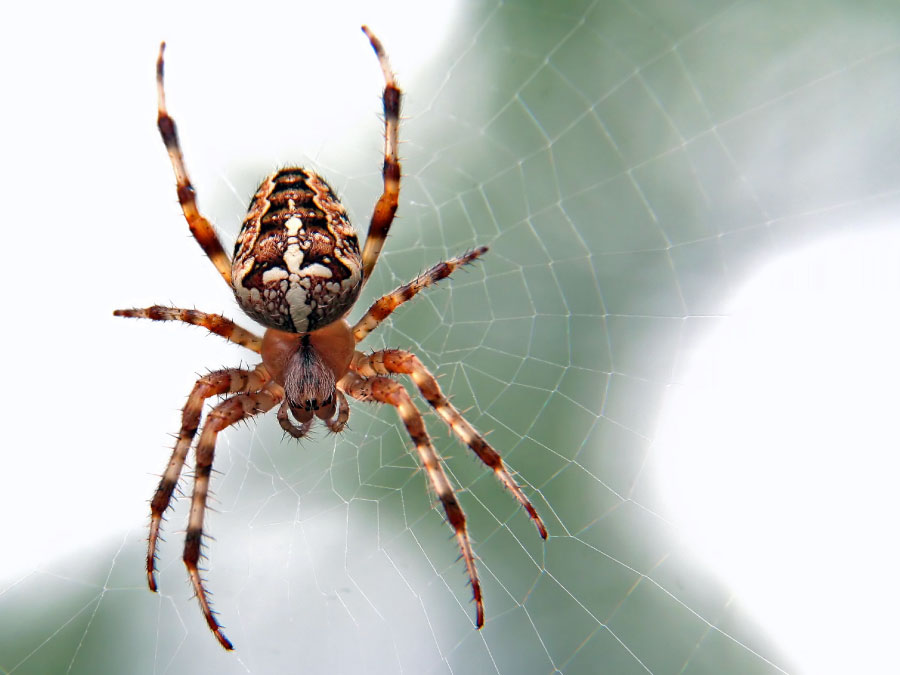
- Grade: Arachnida
The best-known arachnids are spiders, but this arthropod group likewise includes scorpions, camel spiders, mites, ticks and other types of animals.
Arachnids accept iv pairs of legs, and a further two pairs of appendages positioned well-nigh the mouth.
These boosted appendages have a number of different uses depending on the species. The pair closest to the mouth are known as chelicerae. These are the arachnid's 'jaws'. A spider's chelicerae are hollow and are used to inject venom.
The second pair of appendages are known every bit 'pedipalps'. A spider's pedipalps are antennae-like sense organs, and as well play a role in reproduction. A scorpion'south pedipalps accept adjusted into pincers for manipulating casualty.
Spiders are the largest arachnid grouping, with effectually 48,000 recognized species.
Notable Types Of Arachnid
- Subclass Acari – mites and ticks
- Social club Opiliones – harvestmen / daddy longlegs
- Gild Solifugae – camel spiders / air current scorpions / solifuges
- Order Araneae – spiders
- Club Scorpiones – scorpions
Discover More than
- You can discover out more about arachnids on this page: Arachnids: The Ultimate Guide
Back to page alphabetize
Types of Animals: Vertebrates
A vertebrate is an animal with a backbone.
We're vertebrates; if you rub your back you'll probably be able to feel your backbone. Having a courage is something we share not but with our closest relatives in the animal kingdom (the apes) simply with every bird, reptile, mammal, amphibian and fish.
Unlike the invertebrates, vertebrates are part of a recognized biological group: the subphylum Vertebrata. (A subphylum is a subgroup of a phylum; Vertebrata is part of the phylum Chordata.)
This means that every animate being with a backbone shares the same ancestor. Fish were the outset animals to develop backbones, and then in the family tree of every vertebrate (including humans) is a fish!
Fish

- Superclass Osteichthyes (bony fish)
- Grade Chondrichthyes (cartilaginous fish)
The first fish appeared in the Cambrian Period, around 500 1000000 years ago. They were the first vertebrates, and the ancestors of all other vertebrates. Somewhere mode back in your own family tree is a fish!
Annotation: in biology, the word 'fish' applies to a single fish, or a group of the same species of fish. The discussion 'fishes' is used for a group of fish that contains multiple species.
Today there are two primary fish groups: the bony fishes (Osteichthyes) and the cartilaginous fishes (Chondrichthyes).
At that place are likewise two other, smaller, fish groups: the hagfish (form Myxini) and the lampreys (lodge Petromyzontiformes). These last ii groups form a subgroup of Vertebrata known as the 'jawless fishes'.
Bony fish, every bit the name suggests, take skeletons made of bone. There are two main types of bony fish: the Actinopterygii, or ray-finned fishes, and the Sarcopterygii, or lobe-finned fishes.
The ray-finned fishes, with over 32,000 known species, account for the vast bulk of living fish. Their fins are thin and supported by spiny bones. Most ray-finned fish accept swim-bladders. These gas-filled sacs regulate buoyancy.
The fins of lobe-finned fish are fleshy, and extend from the trunk on curt stalks. Lobe-finned fish are the ancestors of all not-fish vertebrates, including mammals.
Very few living species of lobe-finned fish remain. Those that exercise include the coelacanths and the lungfish.
Cartilaginous fish include the sharks, rays, skates and sawfish. Their skeletons are made not of bone, just of a natural substance chosen cartilage. The whale shark is not only the world's largest shark, but too the world's largest fish.
Notable Fish Groups
- Form Actinopterygii – ray-finned fishes
- Grade Sarcopterygii – lobe-finned fishes
- Subclass Elasmobranchii – (sharks, rays, skates, sawfish)
Dorsum to page index
Amphibians
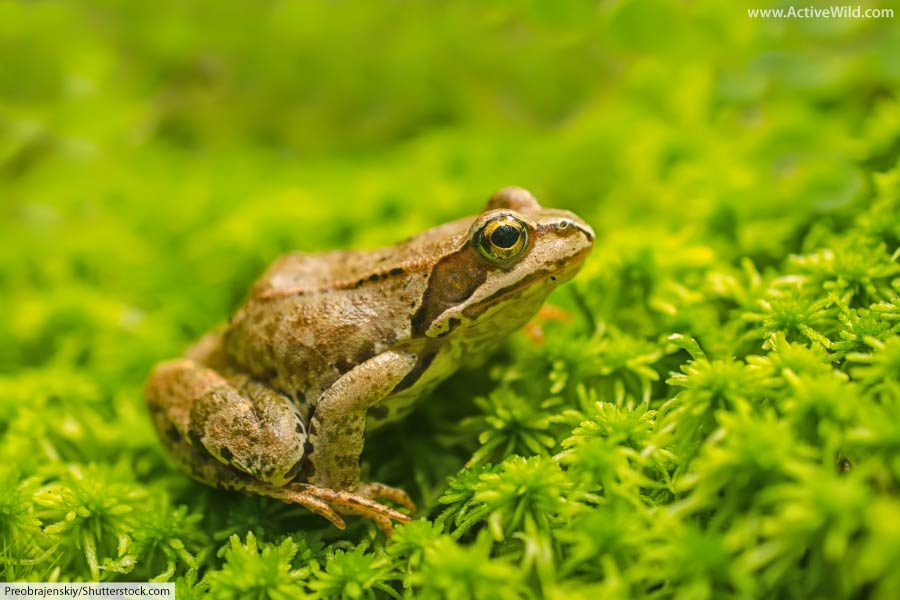
- Class Amphibia
Amphibians evolved from four-footed animals known every bit tetrapods, which themselves had evolved from lobe-finned fishes. (Another branch of tetrapods, Amniota, are the ancestors of all living reptiles, birds and mammals.)
The early amphibians were the dominant animals on state. Large crocodile-similar amphibians preyed on fish and other aquatic animals.
This changed when the amniotes evolved the ability to lay eggs on land. Once freed from their reliance on water for reproduction, early reptiles and the ancestors of mammals became the dominant country animals.
Today there are 3 primary types of amphibians: the Anura (frogs and toads), Urodela (salamanders), and Apoda (caecilians).
Characteristics of amphibians include: eggs laid in h2o, an aquatic larval stage, moist skin capable of gas exchange, a terrestrial (land-dwelling) developed stage. (Some amphibians have evolved means of avoiding the larval stage and give birth to live immature. Others retain their gills and remain aquatic even in adulthood.)
Major Types Of Amphibian
- Order Anura (frogs and toads)
- Order Urodela (salamanders)
- Order Apoda (caecilians)
Discover More
- You lot can find out more about amphibians on this page: Amphibians: The Ultimate Guide
Back to page index
Reptiles
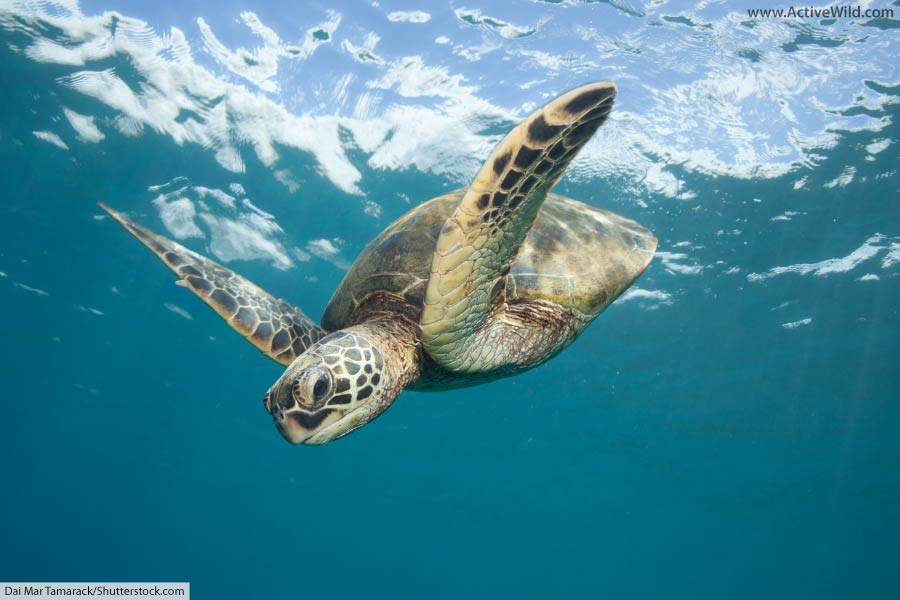
- Class Reptilia
Reptiles are common cold-blooded animals that descended from a group of animals called tetrapods, which themselves had evolved from lobe-finned fish. Well-nigh reptiles lay eggs, but some give birth to live young.
During the Mesozoic Era reptiles became the dominant country animals, just their reign was ended by the meteor strike which caused the Cretaceous-Paleogene Extinction Event.
Living reptile groups include: Testudines (turtles and tortoises); Rhynchocephalia (the tuatara); Squamata (lizards and snakes); and Crocodilia (crocodiles, gavials, caimans, and alligators).
The world's largest reptile is the saltwater crocodile (Crocodylus porosus). Reaching lengths of up to 6 g (xx ft.), this fearsome species is found in Australia and Southeast Asia.
There are just over 10,000 known reptile species. By far the largest grouping of reptiles (in terms of number of the number of species information technology contains) is Squamata.
Some scientists consider birds to be reptiles as they are the direct descendants of the dinosaurs. The inclusion of birds into Reptilia would roughly double the number of known reptiles.
Major Types Of Reptile
- Society Testudines (turtles and tortoises)
- Guild Rhynchocephalia (the tuatara)
- Order Squamata (lizards and snakes)
- Order Crocodilia (crocodiles, gavials, caimans, and alligators)
Discover More
- Y'all tin discover out more than about reptiles on this page: Reptiles: The Ultimate Guide
Back to page index
Birds
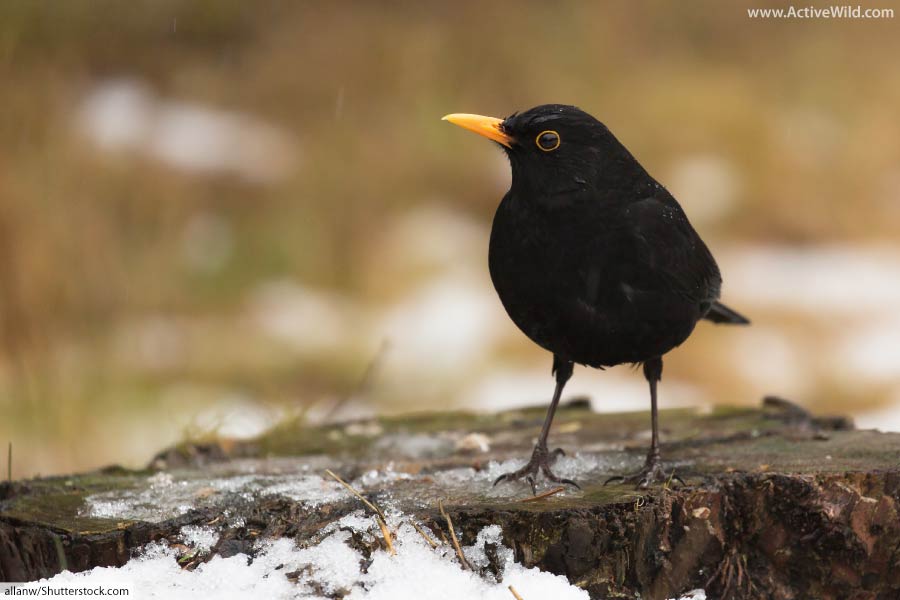
- Course Aves
Not all dinosaurs became extinct in the Cretaceous-Paleogene Extinction Upshot. Birds are directly descended from dinosaurs, and for this reason many scientists consider birds to be dinosaurs.
Today, there are around x,000 known bird species. They range in size from the tiny bee hummingbird to the common ostrich.
The vast majority of living birds belong to the infraclass Neognathae. Just 60 species belong to the other chief bird grouping, Palaeognathae. These include the tinamous of the Americas and the flightless kiwis, cassowaries, emu, rheas and ostriches.
Characteristics of mod birds include having feathers, toothless bills, forelimbs modified into wings, and laying eggs.
The showtime true birds appeared during the Cretaceous Period. During this time they would have shared the sky with the offset flying vertebrates – the Pterosaurs.
Notable Types Of Bird
- Social club Accipitriformes – birds of prey: hawks, eagles kites
- Guild Anseriformes – waterfowl: ducks, geese, swans & related species
- Order Charadriiformes – gulls, auks & waders
- Order Galliformes – gamefowl: turkeys, chickens, partridges, pheasants & related species
- Order Passeriformes – perching birds / songbirds
- Order Piciformes – woodpeckers
- Order Psittaciformes – parrots
- Order Strigiformes – owls
Find More
- Yous tin notice out more well-nigh birds on this page: Birds: The Ultimate Guide
Back to page index
Mammals

- Class Mammalia
The start true mammals starting time appeared during the Late Triassic, around 200 to 227 million years ago. While sharing Globe with the dinosaurs, the early mammals were past necessity small and nocturnal.
The Cretaceous-Paleogene Extinction Event spelt the terminate of the dinosaurs' reign. With the dinosaurs gone, mammals rapidly became the dominant state animals. They evolved to fill many different niches, even returning to the bounding main in the shape of whales and dolphins.
Characteristics of mammals include: having hair, giving nascency to live immature (only five species of mammal, the monotremes, lay eggs), being warm-blooded, animate air with lungs, and having mammary glands.
There are three main types of mammal: monotremes (Monotremata), marsupials (Marsupialia), and placental mammals (Placentalia).
The monotremes, which consist of four species of echidna and the platypus, are the but living egg-laying mammals.
Marsupials are also known as 'pouched mammals'. Their young are built-in in a relatively undeveloped state. They undergo further evolution in a special pouch in the mother's body, where they have admission to milk.
Placental mammals give birth to immature at a after stage of evolution than marsupials. While in the womb a developing placental mammal is supplied with nutrients via an organ known as a placenta. The placenta also handles gas-exchange and removes waste products.
Major Mammal Groups
- Order Artiodactyla – fifty-fifty-toed ungulates: cattle, pigs, sheep, deer, antelopes, giraffes, camels, hippopotamuses and related species
- Infraorder Cetacea (part of Artiodactyla): whales, porpoises, dolphins
- Order Carnivora: dogs, cats, seals, weasels, bears & related species
- Order Chiroptera: bats
- Guild Diprotodontia: kangaroos, possums, wombats & related species
- Lodge Lagomorpha: rabbits, hares & related species
- Social club Monotremata: echidnas, platypus
- Order Perissodactyla – odd-toed ungulates: horses, rhinoceroses, tapirs
- Order Primates: lemurs, galagoes, monkeys, apes & related species
- Order Rodentia: rodents
Discover More than
- You can detect out more than about mammals on this page: Mammals: The Ultimate Guide
Back to folio index
Types of Animals: Determination
We promise that you've enjoyed this overview of the animal kingdom and meeting many different types of animals. If you take whatever questions then feel complimentary to inquire them in the comments section at the foot of the page.
Discover More than With Active Wild
Continue your exploration of Animalia past visiting the pages below:
- Animals: The Ultimate Guide To The Animal Kingdom
- Amphibians: The Ultimate Guide
- Reptiles: The Ultimate Guide
- Birds: The Ultimate Guide
- Mammals: The Ultimate Guide
- A to Z Animals With Pictures & Facts
Source: https://www.activewild.com/types-of-animals/
Posted by: carmichaelwassix.blogspot.com

0 Response to "What Are The Three Types Of Skeletons Found In Animals"
Post a Comment